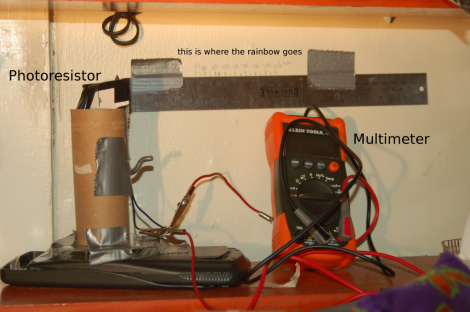
What can you make with a toilet paper roll, duct tape, and a graphing calculator? A stand for your homemade spectrometer. This is neither as pretty nor as accurate as a precision scientific instrument, but that doesn’t mean it’s useless. In fact, it works perfectly well for rudimentary observations. Light is shined through a sample solution, passes through a diffraction grating, then shows up as bands of color on the projection surface seen above. The photosensor mounted on the cardboard tube was pulled from a night-light, and is read using the ruler and the multimeter. This results in two data units that are used to graph the results. As long as you’re running test samples as a control this simple setup will yield useful information for the scientist on a shoe-string budget.
[via BoingBoing]















when iread this
What can you make with a toilet paper roll, duct tape, and a graphing calculator
sorry i must think one thing
macgyver
Nice setup. But if you want to build and use the same design (maybe with a CD or DVD instead of the grating), you should be aware of the overlapping spectra.
Now, THAT’s a hack. Duct tape will be seen as the crowning achievement of the Human race, when we are replaced by intelligent bees or scientific otters. Maybe they will keep us around to run the manufacturing facilities.
ducttape is the bom
you can reaper evrithing whit it
the mythbusters have test it you can repair even a car that is open by the firedepartmant
whats that stuff… ah duct tape, i love duct tape
nice, i thought of doing a spectrophotometer but couldn’t think of how to sweep the entire spectrum
he just uses a photosensor and moves it,
it is really crude though
he does go into explaining where it lacks but i think he left out a lot too like how the photosensor could absorb different wavelengths differently
spectrophotometers can do a couple other things too but this is fine for basic stuff
This is AWESOME! I can finally measure the IBUs of homebrew beer!
http://www.hereforthebeer.com/ibu-the-international-bitterness-unit/
This reminds me of the cellphone spectrophotometer I read about when looking for a simple solution for e. coli cell counting…it uses any form of JPG creating camera to get intensity measurements (ie a cameraphone, like so many cell phones are these days)
http://www.asdlib.org/onlineArticles/elabware/Scheeline_Kelly_Spectrophotometer/index.html
-sCi
just a thought, but the linear CCD from a broken all-in-one printer could work here.
plus its already set up to detect a wide range of wavelengths as long as its one of the units that uses a RGB LED to select the colour.
currently have 6 of these sitting in my spares box :-)
“left out a lot too like how the photosensor could absorb different wavelengths differently”
There’s no “could”, photoresistors do absorb colors differently.
What I think is the most important he left out is how to calibrate it. You can calibrate the wavelengths with cheap laser pointers (total $15 – $5 for a 650nm and $10 for a 532nm from Hong Kong). Then you can calibrate the levels using photography grade incandescent lightbulbs, just relate the readings to the wikipedia graphs on the blackbody spectrum for the color temperature of your bulb, and use that to more or less correct the response of the photoresistor.
Or if you’re feeling adventurous you can try to use the Fraunhofer lines.
Should’ve probably also mention’d that if you’re only going to use it to measure transmission, simply make a graph with just the light source and then substract that from actual readings. Instant flat response.
I’ve had good results making a spectrometer out of a camera (raw or JPEG) and a piece of inexpensive transmissive diffraction grating. I’ve written a whole series of articles on how to make a spectroscope and how to convert the spectrographs into spectrograms using some open source code I wrote for GNU Octave/MATLAB. I also discuss how to determine the spectrometer’s system function which is dominated by the Bayer filters’ spectra and the spectral response of the CCD.
The spectrometer is easily calibrated for wavelength using the mercury peaks in a CFL. I just figured out how to radiometrically calibrate it a couple days ago; I’ll post a write-up on that in a week or so.
For the whole series of articles:
http://jethomson.wordpress.com/spectrometer-articles/
Or if you just want to see pictures:
http://jethomson.wordpress.com/spectrometer-articles/how-to-build-a-spectroscope/
I was unaware that one could polish light… or did you mean that light is /shone/ through the sample solution?
Neat hack, but why the calculator? Why not just tape the tube to the meter itself and make it self-contained?
Shined is correct if the light source shines on the direct object, which is the case in the summary. Here’s a couple of examples to make it clearer:
The sun shone on Friday.
The sun shined on Friday.
In the first sentence, Friday is a day of the week; in the second, Friday is Robinson Crusoe’s companion.
It’s starting to look like a triple rainbow
That’s a full rainbow oh my god
Thank for the mention! I’ve posted some further discussion here: http://topologicoceans.wordpress.com/2011/01/29/diy-spectro-faq/ and an update is on the way!